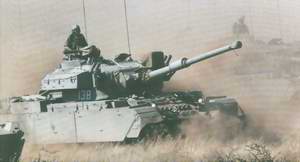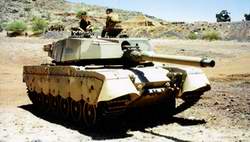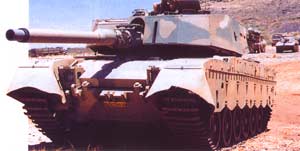| Designation: | OLIFANT |
 |
|---|---|---|
| Manufacturer: | LIW, a division of Denel (Pty) Ltd | |
| Product type: | Armoured Vehicles | |
| Name: | Main battle tank |
It has been revealed that before the introduction of the Olifant Mk 1A there were a number of other Centurion MBT upgrades in South Africa.
In 1972, the Centurion was fitted with a V-12 fuel-injected petrol engine developing 810 hp coupled to a new three-speed (two forward and one reverse) automatic transmission. This project was called the Skokiaan but only eight conversions were made.
This was followed by the Semel project in 1974 which involved fitting the eight Skokiaan vehicles and some unconverted Centurions with a modified engine and some other improvements and these were called the Centurion Mk 5A or Semel. A total of 35 of these vehicles was produced and some were used in the then southwest Africa.
These vehicles were followed by the Olifant Mk 1 whose development commenced in 1976, with the first prototype being completed the same year followed by the second in 1977 and the third in 1978. This was then accepted for service with the South African Armoured Corps.
The Olifant Mk 1 has the same power pack as the Semel but also incorporates many other modifications, especially to the subsystems, including the suspension, turret drives and vision equipment. The tank commander was also provided with a hand-held laser range-finder.
This was followed by the Olifant Mk lAwhich entered production in 1983 and entered service two years later and subsequently saw combat service in Angola.
This has all the improvements of the Olifant Mk 1 but also has a number of other improvements. Modifications over the original Centurion can be summarised as the installation of a 105 mm L7-type rifled tank gun, a bank of eight 81 mm electrically operated smoke grenade dischargers either side of the turret and a new power pack consisting of a V-12 diesel engine developing 750 hp coupled to a semi-automatic transmission. Passive night vision equipment has been installed as has a new commander's cupola.
The Olifant Mk 1A does not have a computerised fire-control system but the commander is provided with an AFV No 4 sight and the gunner with an AFV No 18 sight with magnifications of x1 and x6, range drum, elevation indicator and a traverse indicator.
The gunner is provided with an Eloptro MSZ-2 two-channel sight with an integral laser range-finder working in both channels. The right-hand channel has a x8 magnification and an 8° field of view while the left-hand channel houses the night elbow which has an image intensifier with a x7.2 magnification and a 7.5° field of view. If required, the night elbow can be replaced by a x1 magnification observation prism.
The driver can replace his standard day periscope with a locally designed passive night vision device.
The installation of the new power pack greatly increases the operational range of the Olifant 1A compared with the original Centurion as the diesel engine is much more fuel efficient; in addition, fuel tanks with a significant increase in capacity have been fitted.
Development work on the Olifant Mk 1B commenced in 1983, with the first prototype being completed in 1985. Following trials with prototype vehicles by the South African Armoured Corps, the first production Olifant Mk 1B vehicles were completed in early 1991. It is believed that the first production batch of Olifant Mk 1B amounted to just under 50 vehicles. This upgrade programme has now been completed.
The South African Olifant MBT programme was carried out by OMC Engineering (Pty) Limited with the OMC standing for the Olifant Manufacturing Company. Today this is known as Reumech OMC.
The overall layout of the Olifant Mk 1A and Mk 1B is virtually identical to that of the basic Centurion MBT described under the UK.
Whereas the Olifant Mk 1A is based on the original Centurion MBT, the Mk 1B is a complete rebuild and incorporates many features not previously fitted to the Centurion. These can be summarised as:
(1) Replacement of the bogie-type suspension by torsion bars which greatly improve cross-country mobility. Total wheel travel is now 435 mm. The first and last two roadwheel stations either side have a hydraulic damper with hydraulic bump stops at each wheel station
(2) The hull now has a double floor with the torsion bars between the two floor plates; the double floor also provides increased protection against mines
(3) New power pack consisting of a V-12 diesel developing 950 hp coupled to a new AMTRA III automatic transmission with four forward and two reverse gears, which also incorporates a double-differential steering system with a two-speed mechanical steering drive and hydraulic retarder
(4) Fitting of new final drives with a ratio of 6.167:1
(5) Installation of additional passive armour to the glacis plate, nose, forward part of the turret roof and turret front and sides. Turret front and side armour is placed well away from the actual turret
(6) Fitting of modular side skirts that provide some protection against HEAT attack as well as helping to keep dust down
(7) Redesign of the driver's compartment with new single-piece lift and swing-type, hatch cover and three new periscopes, one of which can be replaced by a passive night vision device. A hull escape hatch is fitted. The driver has a new instrument panel and the tillers have been replaced by a yoke-type system
(8) A turret bustle is fitted for increased stowage
(9) Two new unity-powered roof-mounted periscopes are fitted for the loader, who also has a new one-piece hatch cover
(10) The 105 mm gun L7 is now fitted with a thermal sleeve and a fume extractor
(11) New solid-state gun control equipment
(12) Gunner's sight now has day/night capability and incorporates a laser rangefinder for improved first round hit capability. Commander has new day/ night sight
(13) The headlamps are now armoured to enhance bush bashability (14) Mounted over the main armament is an infra-red/ white light searchlight that moves in elevation with the main armament
(15) Crew compartment (driver's and fighting) is fitted with a fire detection/suppression system.
The Olifant Mk 1B has a combat weight of 58 tonnes and a maximum speed of 58 km/h and a total of 68 rounds of 105 mm ammunition is carried.
For operations in dense bush the Olifant can be fitted with a V-shape bush basher bar which is mounted on the front of the tank and enables the vehicle to push its way through dense bush without sustaining damage.
The nose of the Olifant can be fitted to take an electrohydraulic dozer blade or mechanical mine rollers. The 3.5 m wide dozer blade weighs 1,500 kg and takes 7 minutes to install using a crane and 15 minutes without a crane.
- Olifant 2 turret
The LIW Division of Denel have developed to the prototype stage a new turret called the Olifant 2. This is claimed to be a state-of-the-art MBT turret featuring hunter-killer, fire-on-the-move and day/night target engagement capabilities.
Main armament can either be the LIW 105 mm GT-8 rifled tank gun or a LIW developed 120 mm smooth bore gun. A 7.62 mm machine gun is mounted coaxial with the main armament and banks of electrically operated smoke grenade launchers are mounted either side of the turret towards the rear.
The gunner, seated on the right hand side and toward of the commander, is provided with a periscope stabilised day/thermal sighting system that incorporates a laser range-finder. The tank commander has an independent panoramic stabilised day/passive night sight.
In a typical target engagement the target would first be acquired by the tank commander who would then hand over the target to the gunner. The tank commander would then start to search for another target to be engaged.
The turret is also fitted with a full solution fire-control system with automatic sensors for meteorological parameters and dynamic tilt together with a state-of-the-art gun and turret drive system. According to LIW, the turret has a high hit probability when the vehicle or the target is moving or stationary.
Protection for the crew of three is provided by means of modular armour packages that are attached to the all welded steel shell. The front of the turret is shaped like an arrow head in a similar manner to that of the latest German Leopard 2A5 MBT. A turret bustle mounted ammunition carousel is suitable for the stowage of kinetic ammunition.
Crew protection from ammunition ignition is enhanced by blow off panels on the turret roof in a similar manner to those of the US M1 Abrams series of MBT.
Ready rounds of ammunition are located in the turret basket for ease of access by the gunner positioned on the left hand side of the turret. According to LIW a comfortable rate of fire of 10 rounds per minute can be achieved.
The turret basket and ring gear are fully compatible with the British developed Centurion and Chieftain MBTs.
It was expected that the current Olifant Mk 1 series of MBT would have been replaced by a new MBT in the early part of the 21 st century.
There were two contenders to meet this requirement, the French Giat Industries Tropicalised Leclerc and the British Vickers Defence Systems Challenger 2E.
The requirement was for 96 new MBTs, six armoured recovery vehicles and four armoured vehicle launched bridges on a similar chassis.
Late in 1998 South Africa announced that it was to order a major package of new defence equipment but MBTs were not part of this package.
It is now possible that South Africa will upgrade its Olifant 1 series MBTs to extend their operational lives.
- Mineclearing Vehicle
The Olifant Mk 1A and Mk 1B can both be fitted with plough- or roller-type mineclearing systems.
- Armoured Recovery Vehicle
An armoured recovery vehicle based on the chassis of the Olifant Mk 1A has been completed and is now in service with the South African Armoured Corps. Details are given in Jane's Military Vehicles and Logistics 1999-2000, page 50.
- Armoured Vehicle-Launched Bridge
South Africa has developed an armoured vehicle-launched bridge based on a Centurion (Olifant) MBT chassis. This bridge is not of the scissors type and is extended over the front of the vehicle.
Conversions to Mk 1A and Mk 1B have been completed. Late in 1996, South Africa stated that it had a total of 224 Olifant Mk 1A and Mk 1B MBTs in service. In addition there were 28 bridge-laying tanks, 10 bridge-laying vehicles, 20 bridge carrying vehicles and 30 26 m bridges.
|
||||||||||||
Related Articles |
|
Rheinmetall at AAD - Leopard 2 steals the show in South Africa (11.10.2010) |
 |
 |
 |
